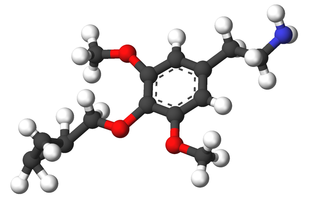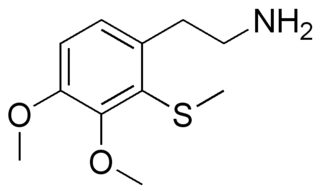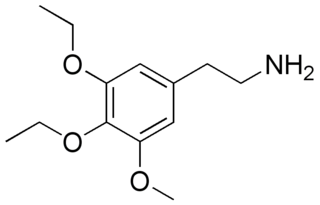
3C-E is a psychedelic of the amphetamine class. It was first synthesized by Alexander Shulgin. In his book PiHKAL, Shulgin lists the dosage range as 30 to 60 mg, consumed orally. The duration of action was stated to be 8–12 hours.

2C-G is a psychedelic phenethylamine of the 2C family. First synthesized by Alexander Shulgin, it is sometimes used as an entheogen. It has structural and pharmacodynamic properties similar to 2C-D and Ganesha. Like many of the phenethylamines in PiHKAL, 2C-G and its homologs have only been taken by Shulgin and a small test group, making it difficult to ensure completeness when describing effects.
Ganesha (2,5-dimethoxy-3,4-dimethylamphetamine) is a lesser-known psychedelic drug. It is also a substituted amphetamine. It was first synthesized by Alexander Shulgin. In his book PiHKAL, the dosage range is listed as 24–32 mg. The drug is usually taken orally, although other routes such as rectally may also be used. Ganesha is synthesized from 2,5-dimethoxy-3,4-dimethylbenzaldehyde. Ganesha is the amphetamine analog of 2C-G. It is a particularly long lasting drug, with the duration listed in PiHKAL as being 18–24 hours, which might make it undesirable to some users. It is named after the Hindu deity, Ganesha. Very little is known about the dangers or toxicity of ganesha. Effects of ganesha include:

Aleph is a psychedelic hallucinogenic drug and a substituted amphetamine of the phenethylamine class of compounds, which can be used as an entheogen. It was first synthesized by Alexander Shulgin. In his book PiHKAL, Shulgin lists the dosage range as 5–10 mg. According to Shulgin, the effects of aleph typically last for 6 to 8 hours.

3,4-Methylenedioxy-N-methylphentermine is a lesser-known psychedelic drug. MDMP was first synthesized by Alexander Shulgin. In his book PiHKAL, the minimum dosage is listed as 110 mg, and the duration is listed as approximately 6 hours. MDMP produces few to no effects, and is slightly similar to MDMA. Very little data exists about the pharmacological properties, metabolism, and toxicity of MDMP.

3,4-Methylenedioxy-N-hydroxyamphetamine is an entactogen, psychedelic, and stimulant of the phenethylamine and amphetamine chemical classes. It is the N-hydroxy homologue of MDA, and the N-desmethyl homologue of MDHMA. MDOH was first synthesized and assayed by Alexander Shulgin. In his book PiHKAL, Shulgin listed the dosage range as 100–160 mg, and the duration as approximately 3–6 hours. He describes MDOH as being very psychedelic and producing increased pleasure in beauty and nature. He also mentioned several negative side effects also seen with MDMA ("Ecstasy") such as difficulty urinating and internal dryness.

3,4-Methylenedioxyphentermine (MDPH) is a lesser-known psychedelic drug. MDPH was first synthesized by Alexander Shulgin. In his book PiHKAL , the dosage range is listed as 160–240 mg, and the duration as 3–5 hours. MDPH's effects are very similar to those of MDA: they both are smooth and "stoning," and do not cause any visuals. They also alter dreams and dream patterns. Shulgin describes MDPH as a promoter; it promotes the effects of other drugs, similarly to 2C-D. Very little data exists about the pharmacological properties, metabolism, and toxicity of MDPH.

3C-BZ (4-benzyloxy-3,5-dimethoxyamphetamine) is a lesser-known psychedelic drug and a substituted amphetamine. 3C-BZ was first synthesized by Alexander Shulgin. In his book PiHKAL, the dosage range is listed as 25–200 mg and the duration as 18–24 hours. According to anecdotal reports from the substance's entry in PiHKAL, 3C-BZ's effects can vary significantly, ranging from intensified emotions and strange dreams, to effects similar to those of LSD or TMA. Very little data exists about the pharmacological properties, metabolism, and toxicity of 3C-BZ.

3,4-Methylenedioxy-N-propylamphetamine is a lesser-known psychedelic drug and a substituted amphetamine. MDPR was first synthesized by Alexander Shulgin. In his book PiHKAL, the minimum dosage is listed as 200 mg, and the duration unknown. MDPR is a promoter; by itself it has almost no effects on the mind, but it promotes the effects of hallucinogens, similarly to the closely related MDPH.

3,4-Ethylenedioxy-N-methylamphetamine (EDMA) is an entactogen drug of the methamphetamine class. It is an analogue of MDMA where the methylenedioxy ring has been replaced by an ethylenedioxy ring. EDMA was first synthesized by Alexander Shulgin. In his book PiHKAL, the dosage is listed as 150–250 mg, and the duration listed as 3–5 hours. According to Shulgin, EDMA produces a bare threshold consisting of paresthesia, nystagmus, and hypnogogic imagery, with few to no other effects. Scientific research has demonstrated that EDMA acts as a non-neurotoxic serotonin releasing agent with moderately diminished potency relative to MDMA, and with negligible effects on dopamine release.

Cyclopropylmescaline is a lesser-known psychedelic drug. CPM was first synthesized by Alexander Shulgin. In his book PiHKAL, the dosage range is listed as 60–80 mg and the duration listed as 12–18 hours. CPM produces closed-eye imagery, visuals, and fantasies. It also causes enhancement of music. Very little data exists about the pharmacological properties, metabolism, and toxicity of CPM.

TIM, or thioisomescaline, is a series of lesser-known psychedelic drugs similar in structure to mescaline. They were first synthesized by Alexander Shulgin. In his book PiHKAL , none of their durations are known. Very little is known about their dangers or toxicity.

Asymbescaline (3,4-diethoxy-5-methoxyphenethylamine) is a lesser-known psychedelic drug. It is a homolog of mescaline. Asymbescaline was first synthesized by Alexander Shulgin. In his book PiHKAL, the dosage range is listed as 200–280 mg, and the duration listed as 10–15 hours. Asymbescaline produces few to no effects. Very little data exists about the pharmacological properties, metabolism, and toxicity of asymbescaline.
TASB, or thioasymbescaline, is a series of lesser-known psychedelic drugs similar in structure to asymbescaline and to mescaline. They were first synthesized by Alexander Shulgin and written up in his book PiHKAL . Very little is known about their dangers or toxicity.

Buscaline (3,5-dimethoxy-4-butoxyphenethylamine) is a chemical compound prepared as a possible psychedelic drug. It is an analog of mescaline. Buscaline was first synthesized by Alexander Shulgin. In his book PiHKAL, the minimum dosage is listed as 150 mg, and the duration is "several hours". Buscaline produces no psychedelic or psychoactive effects, but causes heart arrythmia and light diarrhea. It does not cause any visuals or insights. Very little data exists about the pharmacological properties, metabolism, and toxicity of buscaline.

3,4-Methylenedioxy-N-hydroxy-N-methylamphetamine is an entactogen, psychedelic, and stimulant of the phenethylamine and amphetamine chemical classes. It is the N-hydroxy homologue of MDMA ("Ecstasy"), and the N-methyl homologue of MDOH. MDHMA was first synthesized and assayed by Alexander Shulgin. In his book PiHKAL, Shulgin listed the dosage range as 100–160 mg, and the duration as approximately 4–8 hours. He describes MDHMA as causing entactogenic and open MDMA-like effects, easing communication, and increasing appreciation of the senses.
Dimethoxyamphetamine (DMA) is a series of six lesser-known psychedelic drugs similar in structure to the three isomers of methoxyamphetamine and six isomers of trimethoxyamphetamine. The isomers are 2,3-DMA, 2,4-DMA, 2,5-DMA, 2,6-DMA, 3,4-DMA, and 3,5-DMA. Three of the isomers were characterized by Alexander Shulgin in his book PiHKAL. Little is known about their dangers or toxicity.
TOM, or methylthio-methyl-methoxyamphetamine, is a series of lesser-known psychedelic drugs and substituted amphetamines with the molecular formula C12H19NOS. 2-TOM and 5-TOM are the 2- and 5-methylthio analogs of 2,5-dimethoxy-4-methylamphetamine (DOM), respectively. They were first synthesized by Alexander Shulgin and described in his book PiHKAL. Very little is known about their dangers or toxicity.
TOET (methylthio-ethyl-methoxyamphetamines) is a pair of lesser-known psychedelic drugs and substituted amphetamines. 2-TOET and 5-TOET are the 2- and 5-methylthio analogs of DOET, respectively. They were first synthesized by Alexander Shulgin and written up in his book PiHKAL. Very little is known about their dangers or toxicity.

TSB, or thiosymbescaline, is a series of lesser-known psychedelic drugs similar in structure to symbescaline. They were first synthesized by Alexander Shulgin and written up in his book PiHKAL . Very little is known about their dangers or toxicity.
















